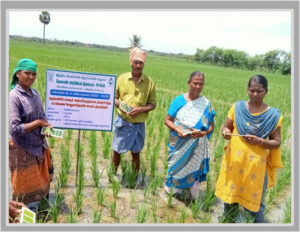On Farm Testing
 On Farm Research is a set of procedures for adaptive research whose purpose is to develop recommendations for representative groups of farmers. In On-farm research, farmers participate in identifying problems and its priorities, managing experiment and evaluating results. On-farm research, therefore, is an adaptive research with farmers perspectives. The objectives of On-farm research is to identify existing inputs or practices that might help to solve major problems of many farmers in a defined study area.
On Farm Research is a set of procedures for adaptive research whose purpose is to develop recommendations for representative groups of farmers. In On-farm research, farmers participate in identifying problems and its priorities, managing experiment and evaluating results. On-farm research, therefore, is an adaptive research with farmers perspectives. The objectives of On-farm research is to identify existing inputs or practices that might help to solve major problems of many farmers in a defined study area.
The procedure of On-farm research has five steps viz.,
i. Diagnosis
ii. Planning
iii. Experimentation
iv. Assessment / Evaluation of results
v. Recommendation and diffusion
There is, however, a considerable overlap and feedback among these five steps.
Diagnosis: The diagnostic stage involves collecting and analyzing information in order to design On-farm experiments. In this steps, an understanding of farmers’ circumstances and practices are made in order to; i) understand the farming system, and system interaction; ii) identify possible productivity problems; and iii) begin to develop hypotheses on possible solutions.
Planning: The planning on On-farm research is used to identify experimental factors to be included in on-farm experiments, as well as to suggest other research activities. There are six practical steps for research planning.
- Listing problems
- Ranking problems
- Identifying causes of problems
- Diagram problems and causes
- Listing possible solutions
- Screening possible solutions for feasibility
Experimentation: On-farm experiments are conducted in the fields of representative farmers and to examine a small number of experimental variables. Those experiments may be described and classified in a number of ways, but regardless of classification most of them progress from exploring production problems, to testing possible solutions, and then to verifying recommendations and demonstrating them with farmers.
Assessment: The results of the on-farm experiments should be analyzed carefully. The analysis requires an assessment of farmers’ reactions and opinions. A thorough agronomic interpretation, and careful statistical and economic analysis will be helpful to this stage. The results of the assessment are then used to plan future research and to make recommendations for farmers.
Recommendation and Diffusion: When researchers are confident that they have enough information, they can formulate recommendations and non-recommendations can be released for demonstration on a larger area in the farmers’ fields.
KVK submits the Action Plan for technical intervention to ICAR – ATARI. Based on the approval KVK conducts On Farm Testing in Field Crops, Horticulture Crops, Farm Implements, Enterprises and Livestock in the district.













 Visit Today : 43
Visit Today : 43